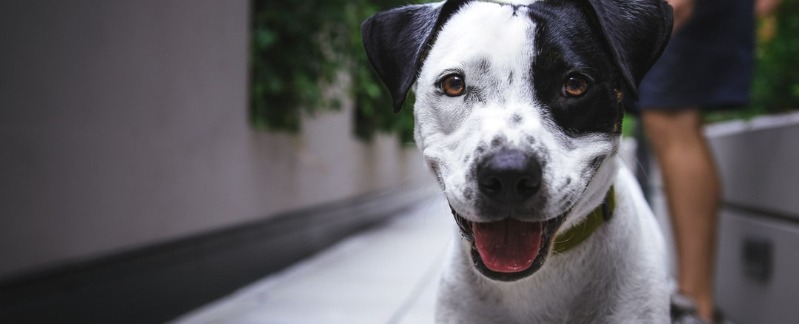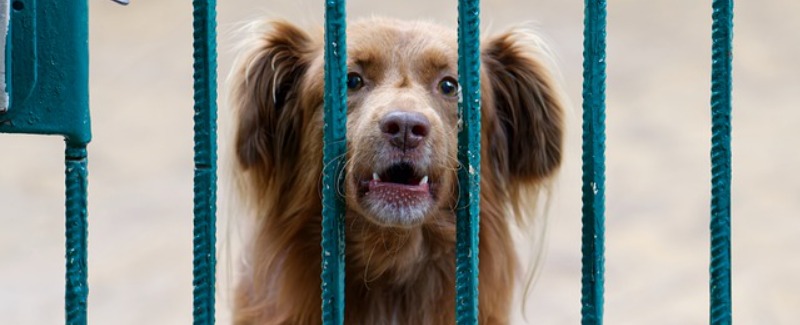A fearful dog is a challenge to own and train. In familiar surroundings, he is a sweet, wonderful family pet, but in new places where there are strange sounds and people, he turns into a mess of jittery shaking nerves. If you own a dog like this, it is important to educate yourself and learn all you can to help your dog become a less fearful and more confident companion.
Make a Commitment to Training
Contents
Fearful dogs do not suddenly become confident, even with lots of training. Training a fearful dog to be more confident is a time-consuming project that is best undertaken with a determined attitude and clear, achievable goals. Being specific about how you want your dog to react and behave is a huge step toward making it a reality.
Be Organized and Consistent
When training a fearful dog, it is important to be flexible. You will not always move in a forward direction. Sometimes it will feel like you move one step forward and ten steps back. Being flexible enough to realize when you’ve pushed too hard and being insightful enough to know what changes to make so that your dog is successful are two of the most important elements of a successful dog trainer.
Having a regular schedule of training is important in training any dog, but it is absolutely critical when working with a fearful dog. Breaking your goals down into steps is the key to seeing improvement in a relatively short period of time.
Using Targeting
Targeting can be a useful tool for fearful dogs. For instance, maybe your dog is afraid of strange men. You may start off by using a male member of your family that your dog likes and teach your dog to target the person’s hand. Targeting involves the dog approaching the strange person and touching her nose to the person’s hand.
Fearful dogs operate on emotion. They do not really think about what they are doing, and therefore no amount of correction or comforting will help them get over it and act like they do at home. If you take on the project of working with a dog like this, you will have to learn to be patient and flexible.
This, of course, would need to be broken down into really tiny pieces if the dog is really afraid of the strange person. For instance, you may want to have the person sit in a chair and ignore the dog at first. Then, you could have the stranger drop small pieces of treats all around his feet and let your dog take her time about going up and eating them.
If your dog is too scared to eat, break it down into something even easier, like having the person lie on the couch or sit a greater distance away. Your dog’s appetite is a good indicator to her comfort level. If she is too stressed to eat, you need to make changes to see any progress.
You would gradually change the variable so that the dog will eventually go and target the person’s hand for a click and treat. Most people who have been successful using targeting to teach their dogs to get over their fears have done an extensive amount of training teaching their dogs to target their own hands and the hands of people the dog likes. Targeting can also be used to teach your dog to learn to be brave around scary objects or to learn to jump into the car or bathtub.
The amount of time you spend training your dog to target will really pay off when you start to apply it in the situations where the dog is afraid. The behavior of targeting becomes a game to the dog if you practice enough.
You will find that because targeting has such good associations for your dog, she will be more willing to extend himself and be open to new experiences; it will give her something to do instead of being scared. Taking the time to teach your dog how to target will be one of the most important training tools you have to help your dog get over her fears.
Genetics, Abuse, or a Lack of Exposure?
People often assume that fearful dogs have been mistreated by a prior owner or some other person who has had contact with the dog. More commonly, however, dogs are fearful or phobic because they lack early experience with lots of different types of people, sounds, and experiences, including other dogs. Genetics can also play a fairly large role in shaping a dog’s fearful behavior, and shyness is a common, though undesirable, trait in some breeds.
Breeding
Good breeders are committed to turning out puppies that are healthy, well adjusted, and ready for life. They screen their potential puppy buyers and make sure they educate each buyer so that they train and socialize their puppies appropriately. The reality is you get what you pay for, and quality puppies from good breeders don’t come cheap. A lot of love and care goes into each puppy if the breeder does his job right.
It is very important to research who you are buying your puppy from and steer clear of puppy mills, pet stores, and places where more than one breed are bred. Select a responsible breeder. The American Kennel Club has a breeder referral service on its website.
If you feel your dog’s problems stem from a genetic component, it is still possible to train him. Even in well-bred dogs with conscientious breeders, some puppies can be more fearful than their littermates. If the shyness is identified early enough, intensive socialization and training can yield positive results in a relatively short period of time. The earlier a problem is identified, the better the prognosis. Certain breeds can be more prone to fearfulness, but any dog can grow up being fearful and suspicious of new people and experiences.
If your dog is under a year old and you feel his fearfulness is a result of a lack of early socialization, get out there and get busy. The earlier you start to change this, the more successful your training program will be. The longer you wait, the harder it will be to change.
Consider enrolling your dog in a well-organized group training class. Be honest with your instructor about what your goals are, and ask if a group class would be an appropriate place to start with your dog. Doggie day care facilities often take on special cases, and the staff is knowledgeable about these problems. They can help make sure your dog has an enjoyable day. Don’t be afraid to ask questions, and be flexible and consistent with your end of the commitment.
Getting a puppy from a person who has been raising dogs for many years and knows how to provide the right kind of environment will save you time in the long run. If a puppy misses out on these critical early social periods and is not raised in an environment that stimulates him to explore and learn about his world, he will be a fearful, phobic adult dog. Shyness, fears, and fear-related aggression are most likely the result of a lack of socialization than past abuse or mistreatment. Abuse is often used as the excuse for dogs who are fearful or aggressive when in reality a lack of early socialization is at the root of the problem.
However, there are mistreated dogs who are fearful and skittish as a result of their experiences. They have learned that strange people and places are scary and dangerous. If your dog has been mistreated, sit down and develop a plan and then get out there and train your dog.
Unrealistic Expectations
The key to success for fearful dogs is to set realistic expectations for their progress. If you weren’t expecting your dog to be fearful, you might want to make the fears go away and get on to the good stuff. This isn’t an ideal attitude to have if you want to bring about the most change. Dogs that are fearful very rarely just get over their fears, because their fears are caused by a variety of factors that we can’t always control. Remember that genetics and early socialization play a huge role in fears and phobias. Not having enough exposure at a young age makes for fearful dogs that don’t recover well from frightening events nor have the skills to deal with new situations that cause them stress.
What are some reasonable expectations for a fearful dog? It depends on the dog and what is causing the fear, but in general you are looking for bounce back — the term used to describe how long it takes the dog to recover from a fright. For instance, you are walking your dog and a big truck passes you. Your dog tries to bolt, tucks her tail, and starts panting. Her eyes are dilated, her ears are pinned back, and she’s terrified. How long does it take her to recover? A minute, 10 minutes, an hour, never? Knowing how long it normally takes your dog to recover from a fright will help you determine if you are making progress in your training plan or if you are just spinning your wheels. If you are making progress, it is likely that your expectations are reasonable and your training program is right on target. If you are not making progress, you will want to re-evaluate your training program and set lower goals, break things down into smaller pieces, and offer more support to your dog.
Veterinary Behaviorists
Veterinary behaviorists are skilled both as veterinarians and as dog behavior experts. You may consider the help of a behaviorist to help diagnose your dog’s problem and help you start working toward a solution. The main difference between a veterinary behaviorist and a dog trainer/behaviorist is that the veterinary behaviorist can prescribe medication for dogs with problems that are too intense or severe to change with training alone.
Consider seeking the help of a veterinary behaviorist if you don’t seem to be making any progress after six weeks or if your dog seems unnaturally fearful. Some dogs are so afraid of being left alone that they will cause injury to themselves or major destruction to their surroundings in the absence of their owners. Dogs like this may benefit from veterinary-prescribed drugs that will help restore chemical balance and assist them in learning appropriate and alternative behavior. If your dog suffers from a chemical imbalance, no amount of training will change that. Restoring the body to its equilibrium will ensure that your dog will be able to make the most of her training sessions and will make progress faster. In most cases, the goal is to wean the dog off the medication by adhering to a strict behavioral program until the dog learns a new response.
Veterinary behaviorists also have experience with difficult or unusual problems, such as excessive tail chasing, shadow chasing, obsessive behaviors, severe separation anxiety, and aggression. A veterinary behaviorist usually charges a substantial fee, which covers the initial visit. On the first visit, the behaviorist will meet your dog and take a complete history to diagnose your dog’s problem and advise you on the treatment.
The behaviorist will most likely design a training program for you to follow and require that you give updates on your dog’s progress. In some cases, the behaviorist may even refer you to a local obedience trainer to help coach you as you implement the training program. Not all problems require medication, but in some severe cases pharmacological intervention can save you huge amounts of time in training and make the success of your training program that much more likely.
Natural Remedies
If you have a dog that has complex behavioral problems, it is crucial to keep an open mind about alternative methods of treatment, such as massage, acupuncture, and homeopathic remedies. Not all solutions will seem to fit your problems or be something you may have even considered.
Holistic veterinary practitioners may use alternative solutions for fearful dogs. Homeopathic remedies often work to help your dog restore her natural balance so that her body can heal itself. If you decide to go this route, the veterinarian will take a detailed history of your dog’s heath and diet and also her likes, dislikes, and general behavioral issues. Consider seeking out a professional to consult with to see what recommendations she might have for your dog. She may use a combination of herbal remedies, body wraps, massage techniques, and behavioral training to help you achieve your goal of a more confident pet. The more alternatives you seek, the more likely you will be to find a solution that will help improve the speed of your dog’s training program.
To find alternative practitioners like acupuncturists, chiropractors, massage therapists, or other types of alternative specialists in your area, try asking other dog owners, looking in the yellow pages, asking at your local health food store, contacting the nearest veterinary school, or doing a search on the Internet.
Alternative Solutions Fear is an emotion that can get in the way of training; because of this, you may find that training alone is not the entire solution. Consider seeking out alternative methods of treatment to be sure you have covered all the bases. Fears are often the result of an injury or underlying medical problem that goes undetected and can often be successfully identified through chiropractic or acupuncture consultations.
Dog Massage Therapy
There are also lots of different massage techniques available for dogs, including the Tellington TTouch. This type of technique helps dogs to become more confident and aware of their bodies and works well in conjunction with a behavior modification program. Regardless of what you start with, the general rule to keep in mind is to do no harm. The more open-minded you are toward trying something new, the more your dog will benefit. If you have a difficult problem, the best approach is to seek out as much information as possible so that you have lots of tools to help your dog live a more comfortable life and make her a more enjoyable companion.
Final Word
In general, phobic dogs are a mix of unfortunate experiences and a lack of early socialization appropriate for their temperament. Retraining these dogs to be more confident can be a challenge. Changing behavior that is based in fear isn’t easy. It requires a huge commitment of time and energy to help your dog learn to cope with life, but the owners who embark on this adventure find the rewards immeasurable. If you are truly committed to making your dog a more confident and participating member of your family, start training your dog today.





